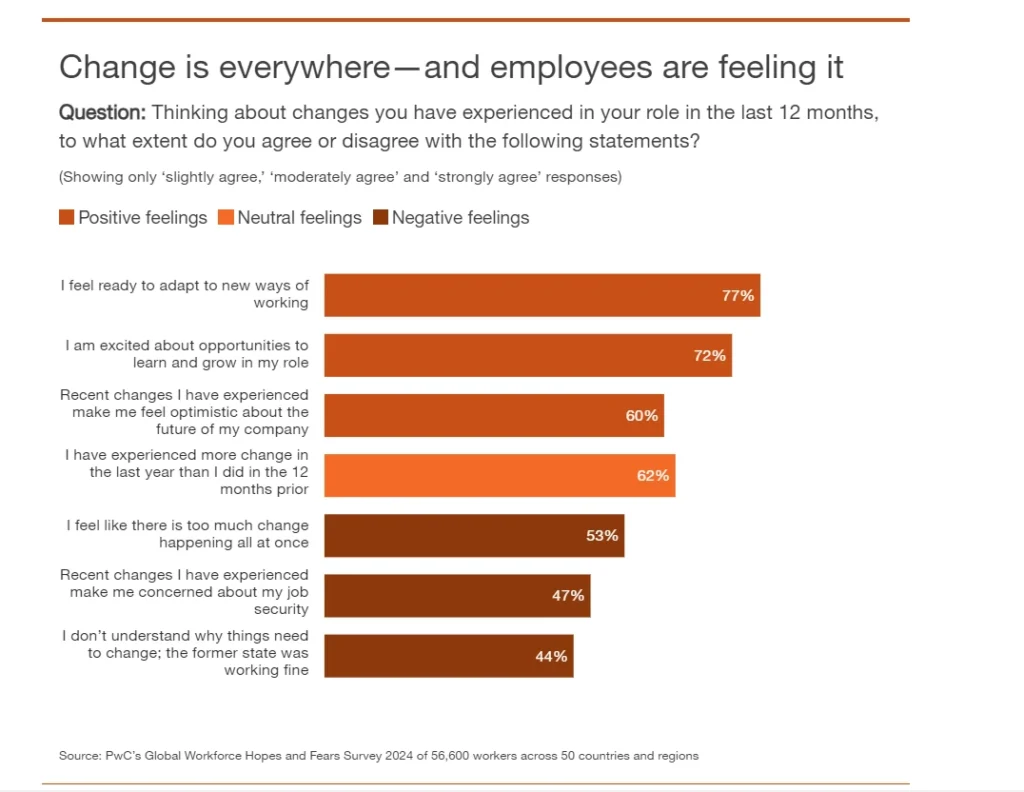As the labor market evolves, employees are increasingly concerned about job security. However, this shift also presents opportunities for upskilling and reskilling ideas for job-risk employees, provided organizations take the initiative. Are you among those ready to adapt?
Key takeaways from the article:
- Upskilling and reskilling ideas for job-risk employees are crucial to help them adapt to automation and technological changes.
- The E-A-A-T framework (Evaluate, Align, Activate, Track) provides a structured approach to employee development.
- PwC’s six actions for building a future-ready workforce focus on leadership, leveraging GenAI, and improving employee experience.
- Investing in continuous learning boosts employee engagement, retention, and performance.
- Organizations need to create a culture that fosters learning, promotes work-life balance, and values fair compensation to motivate employees.
Employees Ready for Reskilling
According to PwC’s 2024 Global Employee Hopes and Fears Survey (with over 56,000 participants from 50 countries), most employees are eager to embrace new work methods, with over 70% viewing generative AI as a tool for efficiency rather than a threat.
Despite this readiness, employees face increased workloads, job insecurity, and financial stress. Organizations must address these concerns through strategic reskilling and upskilling, particularly for jobs vulnerable to automation. Adopting this HR strategy is crucial for retaining talent and preparing for the future workforce.


The Purpose of Reskilling and Upskilling
Reskilling and upskilling equip employees with the skills needed for current and future market demands. The World Economic Forum predicts that by 2025, 50% of employees will require reskilling due to technological advancements. Investing in employee development mitigates the impact of automation and prepares the workforce for future challenges like demographic shifts and climate change.
This approach focuses on four key areas:
- Adaptability: A well-trained workforce can navigate changes and seize new opportunities.
- Engagement and Retention: Investing in development fosters job satisfaction and loyalty.
- Continuous Learning: Promoting skill acquisition creates a culture of innovation.
- Competitive Advantage: Skilled employees help organizations excel and innovate.
Managing these areas ensures businesses are prepared for future market challenges and helps create a workforce equipped for the future.
IDEA 1: The E-A-A-T Framework for Reskilling and Upskilling
One strategy for retraining and upskilling employees is the E-A-A-T framework, which offers a comprehensive approach to preparing employees for future challenges.
Evaluate
E-A-A-T (Evaluate-Align-Activate-Track) is a framework that starts with evaluating current skills. HR managers must audit employee skills to identify gaps and anticipate future needs.
Align
The next step is aligning training content and programs with the company’s business goals and the employee’s career aspirations.
Company training should be:
- interesting and engaging for learners,
- should communicate the company’s vision,
- should engage employees in the learning process,
- should enable the creation of personalized learning paths.
Activate
After alignment, retraining efforts should be activated in this framework through a multi-faceted training approach, including on-the-job learning, mentoring, digital platforms, and collaborative experiences. Employees should be offered a variety of learning formats, which will provide them with access to a variety of development paths.
Track
The final stage of E-A-A-T is to track progress in reskilling and upskilling employees by regularly assessing skills, monitoring KPIs, collecting employee feedback and conducting ROI analysis. Continuous monitoring and improvement ensures that the strategy meets its objectives and supports both the company’s development and employee skills.
IDEA 2: PwC’s 6 Actions To Build a Future-Fit Workforce
At the beginning of the article, I mentioned the results of PwC’s Global Employee Hopes and Fears survey. The study’s authors suggest six actions that they believe will help build a future-fit workforce in an age of transformation. They divide them into 3 main areas and propose two specific action plans for each:
Leading through transformation
While employees are generally optimistic about change, the rapid pace of transformation can be stressful. Companies should engage leaders to recognize the company’s mood and prioritize positive vibes. Stressed and distracted employees are less likely to perform well. Companies need to create a culture of work-life balance where leaders set realistic expectations and communicate openly, with empathy and transparency.
It is important for leaders to communicate frequently and transparently with lower-level employees. Leaders must explain the reasons for change to employees so that they are more engaged and aligned with the organization’s goals. They must also communicate how technological changes affect the company’s strategy.
Equally important is engaging employees by explaining their role in the company’s future and through practical activities such as reskilling and upskilling training using modern learning platforms such as LMS.

Unleashing the power of GenAI
Leaders must encourage employees to innovate and reimagine work to reap GenAI benefits. They must also address the barriers that prevent some employees (and leaders) from using GenAI, such as a lack of employment possibilities. They must also assist staff in developing human skills like communication, leadership, and problem-solving while helping them maximize GenAI.
No matter the sector or position, everyone has to upskill in GenAI. AI may improve work processes and aid decision-making, even if the advantages aren’t immediately apparent. Upskilling ensures workers stay current and don’t fall behind as industries change as AI technology develops and affects every industry. Employee opinions are also very important, so it is worth providing a platform for employees to share their experiences with the AI technologies at your company.
Fueling performance through upskilling and the employee experience
A PwC study suggests that job satisfaction has risen slightly in 2024, but that doesn’t necessarily mean employees will stay with their employers. The survey revealed that a growing number of workers say they will likely change employers in the next 12 months – more than during the “great resignation” of 2022. It sheds light on the psychology of the workforce. What organizations can we do to prevent it?
First, leaders should provide guidance and mentoring on what skills employees need to develop. Second, creating a learning culture that prioritizes creating time for learning in the workplace and providing the tools to do so is important.
At the same time, organizations should be careful not to overlook existing talent. For example, HR can create skills inventories to gain a comprehensive view of employees’ skills and expertise.
Finally, an obvious one, but worth reminding: good pay motivates employees to reskill and upskill. Therefore, companies must strive to provide competitive and fair pay. Company flexibility is also highly valued by employees, it helps employees maintain a work-life balance. As a result, they are more motivated to learn new skills.
Upskilling and Reskilling Ideas For Job-Risk Employees: A Conclusion
In conclusion, adopting upskilling and reskilling ideas for job-risk employees is essential for organizations to stay competitive in a rapidly evolving labor market. By implementing strategies like the E-A-A-T framework and PwC’s actions for building a future-ready workforce, companies can ensure employees remain adaptable, engaged, and prepared for future challenges.











